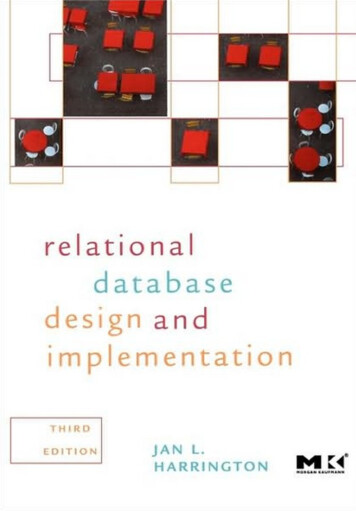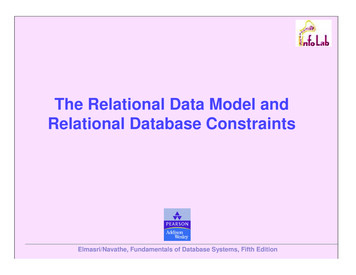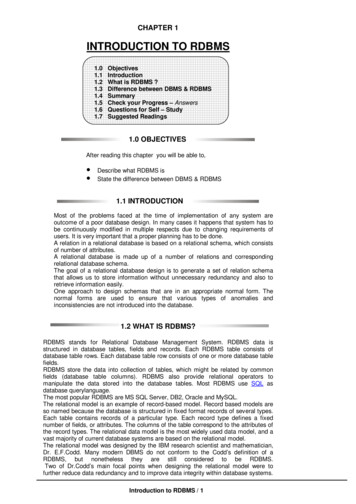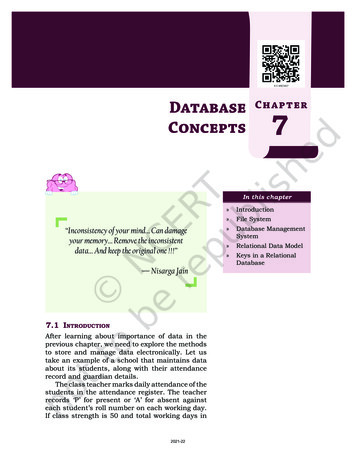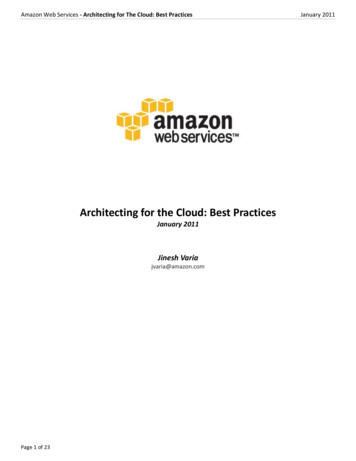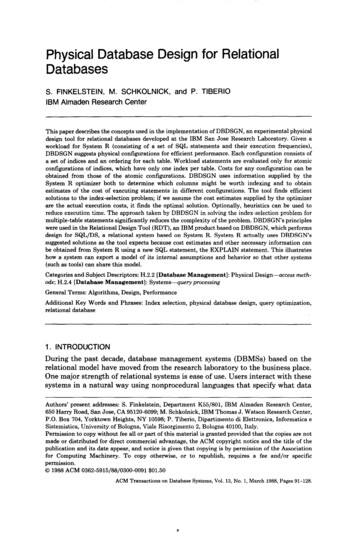
Transcription
Physical Database Design for RelationalDatabasesS. FINKELSTEIN, M. SCHKOLNICK,IBM Almaden Research Centerand P. TIBERIOThis paper describes the concepts used in the implementationof DBDSGN, an experimental physicaldesign tool for relational databases developed at the IBM San Jose Research Laboratory. Given aworkload for System R (consisting of a set of SQL statements and their execution frequencies),DBDSGN suggests physical configurationsfor efficient performance. Each configuration consists ofa set of indices and an ordering for each table. Workload statements are evaluated only for atomicconfigurationsof indices, which have only one index per table. Costs for any configurationcan beobtained from those of the atomic configurations.DBDSGN uses informationsupplied by theSystem R optimizer both to determine which columns might be worth indexing and to obtainestimates of the cost of executing statements in different configurations.The tool finds efficientsolutions to the index-selection problem; if we assume the cost estimates supplied by the optimizerare the actual execution costs, it finds the optimal solution. Optionally, heuristics can be used toreduce execution time. The approach taken by DBDSGN in solving the index-selection problem formultiple-table statements significantly reduces the complexity of the problem. DBDSGN’s principleswere used in the Relational Design Tool (RDT), an IBM product based on DBDSGN, which performsdesign for SQL/DS, a relational system based on System R. System R actually uses DBDSGN’ssuggested solutions as the tool expects because cost estimates and other necessary information canbe obtained from System R using a new SQL statement, the EXPLAINstatement. This illustrateshow a system can export a model of its internal assumptions and behavior so that other systems(such as tools) can share this model.Categories and Subject Descriptors: H.2.2 [Database Management]:ods; H.2.4 [Database Management]:Systems-queryprocessingGeneral Terms: Algorithms,Physical Design-accessmeth-Design, PerformanceAdditional Key Words and Phrases: Index selection, physicalrelational databasedatabase design, query optimization,1. INTRODUCTIONDuring the past decade, database management systems (DBMSs) based on therelational model have moved from the research laboratory to the business place.One major strength of relational systems is ease of use. Users interact with thesesystems in a natural way using nonprocedural languages that specify what dataAuthors’ present addresses: S. Finkelstein, Department K55/801, IBM Almaden Research Center,650 Harry Road, San Jose, CA 95120-6099; M. Schkolnick, IBM Thomas J. Watson Research Center,P.O. Box 704, Yorktown Heights, NY 10598; P. Tiberio, Dipartimentodi Elettronica, Informatica eSistemistica, University.ofBologna, Viale Risorgimento 2, Bologna 40100, Italy.Permission to copy without fee all or part of this material is granted provided that the copies are notmade or distributed for direct commercial advantage, the ACM copyright notice and the title of thepublication and its date appear, and notice is given that copying is by permission of the Associationfor Computing Machinery.To copy otherwise, or to republish, requires a fee and/or specificpermission.0 1988 ACM 0362-5915/88/0300-0091 01.50ACM Transactions on Database Systems, Vol. 13, No. 1, March 1988, Pages 91-128.,
92lS. Finkelstein et al.are required, but do not specify how to perform the operations to obtain thosedata. Statements specify which tables should be accessed as well as conditionsrestricting which combinations of data from those tables are desired. They donot specify the access paths (e.g., indices) used to get data from each table, orthe sequence in which tables should be accessed. Hence, relational statements(and programs with embedded relational statements) can be run independent ofthe set of access paths that exist.There has been controversy about how well relational systems would performcompared to other DBMSs, especially in a transaction-orientedenvironment.Critics of relational systems point out that their nonproceduralityprevents usersfrom navigating through the data in the ways they believe to be most efficient.Developers of relational systems claim that systems could be capable of makingvery good decisions about how to perform users’ requests based on statisticalmodels of databases and formulas for estimating the costs of different executionplans. Software modules called optimizers make these decisions based on statistical models of databases. They perform analysis of alternatives for executingeach statement and choose the execution plan that appears to have the lowestcost. Two of the earliest relational systems, System R, developed at the IBM SanJose Research Laboratory [4, 5, 10, 111 (which has moved and is now the IBMAlmaden Research Center), and INGRES, developed at the University of California, Berkeley [37], have optimizers that perform this function [35, 401.Optimizer effectiveness in choosing efficient execution plans is critical to systemresponse time. Initial studies on the behavior of optimizers [2, 18, 27, 421 haveshown that the choices made by them are among the best possible, for the set ofaccess paths. Optimizers are likely to improve, especially since products havebeen built using them [20, 22, 291.A relational system does not automatically determine the set of access paths.The access paths must be created by authorized users such as database administrators (DBAs). Access-path selection is not trivial, since an index designermust balance the advantages of access paths for data retrieval versus theirdisadvantages in maintenance costs (incurred for database inserts, deletes, andupdates) and database space utilization.For example, indexing every column isseldom a good design choice. Updates will be very expensive in that design, andmoreover, the indices will probably require more total space than the tables. (Thereasons why index selection is difficult are discussed further in Section 2.1.)Database system implementers may be surprised by which index design is bestfor the applications that are run on a particular database. Since those responsiblefor index design usually are not familiar with the internals of the relationalsystem, they may find the access-path selection problem very difficult. A poorchoice of physical designs can result in poor system performance, far below whatthe system would do if a better set of access paths were available. Hence, a designtool is needed to help designers select access paths that support efficient systemperformance for a set of applications.Such a design tool would be useful both for initial database design and when amajor reconfigurationof the database occurs. A design tool might be used when-the-thecost of a prospective database must be evaluated,database is to be loaded,ACM Transactionson Database Systems, Vol. 13, No. 1, March 1988.
Physical Database Design for Relational Databasesl93-the workload on a database changes substantially,-new tables are added,-the database has been heavily updated, or-DBMSperformance has degraded.In System R, indices (structured as B -trees [14]) are the only access paths todata in a table (other than sequentially scanning the entire table). Each index isbased on the values of one or more of the columns of a table, and there may bemany indices on each table. Other systems, such as INGRES and ORACLE [34],also allow users to create indices. In addition, INGRES allows hashing methods.One of the most important problems that a design tool for these systems mustsolve is selecting which indices (or other access paths) should exist in the database[31, 411. Although many papers on index selection have appeared, all solverestricted versions of the problem [l, 6-8, 16, 17, 23, 25, 26, 28, 30, 36, 391. Mostrestrictions are in one of the following areas:(1) Multiple-tablesolutions. Some papers discuss methodologies for accesspath selection for statements involving a single table, but do not demonstratethat their methodologies can be extended effectively to statements on multipletables. One multitabledesign methodology was proposed based on the costseparability property of some join methods. When the property does not hold,heuristics are introduced to extend the methodology [38, 391.(2) Statement generality. Many methodologies limit the set of user statementspermitted. Often they handle queries whose restriction criteria involve comparisons between columns and constants, and are expressed in disjunctive normalform. Even when updates are permitted, index and tuple maintenance costs aresometimes not considered. When they are, they are usually viewed as independentof the access paths chosen for performing the maintenance.(3) Primary access paths. Often the primary access path is given in advance,and methods are described for determining auxiliary access paths. This meansthat the decision of how to order the tuples in each table has already been made.However, the primary access path is not always obvious, nor is it necessarilyobvious which statements should use the primary access path and which shoulduse auxiliary paths.(4) Disagreement between internal and external system models. This problemoccurs only in systems with optimizers. The optimizer’s internal model consistsof its statistical model of statement execution cost and the way it chooses theexecution plan it deems best. The optimizer calculates estimates of cost andcardinality based on its internal model and the statistics in the database catalogs.A design tool may use an external model independent of the model used by theoptimizer. This approach has several serious disadvantages: The tool becomesobsolete whenever there is a change in the optimizer’s model, and changes in theoptimizer are likely as relational systems improve. Moreover, the optimizer maymake very different assumptions (and hence different execution-planchoices)from those made by the external model. Even if the external model is moreaccurate than the optimizer’s model, it is not good to use an external model,since the optimizer chooses plans based on its own model.ACM Transactionson Database Systems, Vol. 13, No. 1, March 1988.
94lS. Finkelstein et al.We believe a good design tool should deal with all the above issues. It shouldchoose the best set of access paths for any number of tables, accept all validinput statements, solve the combined problem of record placement and accesspath selection, and use the database system to obtain both statistics (when thedatabase tables exist) and cost estimates [32]. When the database does not existyet, the tool should accept a statistical description of the database from thedesigner and obtain cost estimates based on those statistics from the databasesystem.In this paper we discuss the basic principles we considered in constructing anexperimental design tool, DBDSGN, that runs as an application program forSystem R. In creating DBDSGN we have attempted to meet all the requirementsdescribed above. We have also discovered some general principles governingdesign-tool construction,and have learned how a DBMS should function tosupport design tools. These principles have been adopted in the Relational DesignTool (RDT) [ 191. RDT is an IBM product, based on DBDSGN, which performsdesign for SQL/DS [20], a relational system based on System R.We developed the methodology for the index-selection problem for System R,but did not forget the more general problem of access-path selection for systemswith hashing and links as well. We discuss the extension of the DBDSGNmethodology to these access paths in Section 7. DBDSGN’s major limitation isits assumption that only one access path can be used for each different occurrenceof a table in a statement; this assumption is false for systems using tuple identifier(TID) intersection methods. We believe the concepts and results that arose fromdesigning and implementingthis tool are also valid for different DBMSs withother access paths; some of the concepts may also be valuable for designingintegrated system families where large systems export descriptions of theirinternal assumptions and behaviors so that other systems (such as tools) canshare them.We assume the reader is familiar with relational database technology andstandard query languages used in relational systems. We use SQL [9] as thequery language.2. THE PROBLEMOF INDEX SELECTIONIN RELATIONALDATABASES2.1 Problem ComplexityData in a database table can be accessed by scanning the entire table (sequentialscan). The execution of a given statement may be sped up by using auxiliaryaccess paths, such as indices. However, the existence of certain indices, althoughimproving the performance of some statements, may reduce the performance ofother statements (such as updates), since the indices must be modified whentables are. In System R, some indices, called clustered indices, enforce the orderingof the records in the tables they index. All other indices are called nonchsteredindices. The overall performance of the system depends on the set of all existingindices, as well as on the ways the tables are stored. Although System R supportsmulticolumn indices (as described in Section 7), this paper focuses on indices onsingle columns.ACM Transactionson Database Systems, Vol. 13, No. 1, March1988.
Physical Database Design for Relational Databases95Given a set of tables and a set of statements, together with their expectedfrequencies of use, the index-selection problem involves selecting for each table-the ordering rule for the stored records (which determines the clustered index,if any), and-a set of nonclustered indices,so as to minimize the total processing cost, subject to a limit on total index space.We define the total processing cost to be the frequency weighted sum of theexpected costs for executing each statement, including access, tuple update, andindex maintenance costs. A weighted index space cost is also added in.Clustered indices frequently provide excellent performance when they are oncolumns referenced in a given statement [2, 351. This might indicate that thesolution to the design problem is to have a clustered index on every column. Sucha solution is not possible, since (without replication) records can be ordered onlyone way. On the other hand, nonclustered indices can exist on all columns andmay help to process some statements. A set of clustered and nonclustered indiceson tables in a database is called an index configuration(or more simply aconfiguration)if no table has more than one clustered index and no columnshave both clustered and nonclustered indices. We will only be interested in indexdesigns that are configurations. A configuration proposed for a particular indexselection problem it is called a solution for that problem.It may seem that finding solutions to the design problem consists of choosingone column from each table as the ordering column, putting a clustered index onthat column, and putting nonclustered indices on all other columns. This failsfor three reasons:(1) For each additional index that exists, extra maintenance cost is incurredevery time an update is made that affects the index (inserting or deleting records,updating the value of the index’s column). Because of the cost of maintenanceactivity, a solution with indices on every column of every table usually does notminimize processing costs.(2) Storage costs must be considered even when there are no updates. Typically, a System R index utilizes from 5 to 20 percent of the space used by thetable it indexes, so the cost of storage is not negligible.(3) Most importantly,a global solution cannot generally be obtained for eachtable independently. Any index decision that you make for one table (e.g., whichindex is clustered) may affect the best index choices for another table.Some examples showing the interrelationshipamong index choices are givenin Section 4.These considerations show that the design problem presented at the beginningof this section does not have a simple solution. Even a restricted version of theindex-selection problem is in the class of NP-hard problems [13]. Thus, thereappears to be no fast algorithm that will find the optimal solution. However, wemust question whether the optimal solution is the right goal, since the problemspecification and the problem that the designer actually wants solved usually areACM Transactionson Database Systems, Vol. 13, No. 1, March1988.
96lS. Finkelstein et al.not identical.Approximationsinclude-the statements that are the input for the problem usually represent an approximation to the actual load that will be submitted to the system,-the frequencies associated with these statements are likely to be approximations,-the statistics for the data the tool uses (which may be given by the designer orderived from the database itself) represent the data a%they exist at the timethe design is done and may not accurately reflect future changes, and-the statistical model used by the optimizer is correct only for some datadistributions. Imprecision exists when the actual data do not fit the underlyingassumptions of the model [2, 121.For these reasons, instead of finding the optimal solution to the index designproblem, we would like to get a set of reasonable design-s, each of which has arelatively low performance cost. From this set a designer can choose the one heor she deems best, based on considerations that may not have been completelymodeled. By an appropriate use of some heuristics, combined with more exacttechniques, DBDSGN can find a set of reasonable solutions quickly. The designermay iterate through several executions of some of DBDSGN’s phases, tuningsimple heuristic parameters to try to achieve better solutions (at the expense ofadditional execution time). A discussion of some of these techniques appears inthis paper.2.2 A Methodology for Index SelectionMethodologies for the index-selectionproblem are based on models of dataretrieval and update. Some solve the problem in a wholly analytic way; othersuse heuristic searches to find a quasi-optimalsolution. However, all previousexamples compute the estimated costs of retrievals and updates using analyticformulas. Since we assume the database management system uses an optimizerto choose an access-path strategy, it makes sense to use the optimizer itself toprovide the estimated processing cost of a given statement. The optimizer examinesthe set of access paths that exist and computes the best expected cost for astatement by evaluating different join orders, join methods, and access choices.By using the optimizer’s cost estimates as the basis for our design tool, we obtainthree significant advantages.First, the tool is independent of optimizer improvements. An analytic expression for the cost of performing a given statement must be based on currentknowledge of the strategy used by the optimizer and will become invalid if theoptimizer computations are altered. For example, suppose a statement includesa predicate on a column for which there is a nonclustered index. An early versionof the System R optimizer determined the cost of accessing the tuples using thenonclustered index by assuming that a data page was read for each retrievedtuple [35]. In a later version of the system, the optimizer recognized that theTIDs are stored in increasing order, so a smaller number of estimated page hitsresults when the number of tuples for a given key value is comparable to thenumber of data pages [2]. This type of change would have an immediate impacton a tool that used an analytic model of the optimizer’s behavior. As anotherexample, two systems based on System R, SQL/DS [20] and DB2 [22], haveACM Transactionson Database Systems, Vol. 13, No. 1, March 1988.
Physical Database Design for Relational Databases97different physical data managers, which lead to differences in their optimizercost models that a design tool should not need to know about.Second, the query may be transformed to an equivalent form before it reachesthe optimizer (or by the optimizer itself). For example, nested queries may betransformed to joins [ 15, 241. A tool using an external model may not understandthese transformations;even if it does, it will have to be changed when thetransformationschange.Third, using the optimizer we can guarantee any proposed solution is one theoptimizer will use to its full advantage. Working with an external model couldresult in a solution that has good performance according to the analytic model.However, when the optimizer is confronted with the set of access paths describedin the solution it may choose an execution plan different from the one predictedby the tool, which may result in poor performance. To illustrate this, consideran example involving the tableORDERS:(ORDERNO,SUPPNO,PARTNO,DATE,QTY, . . . .)in the TNO DATEBETWEEN870601 AND870603.An external model based on more detailed statistics than those available to theoptimizer might suggest that an index I nATE on DATE performs much betterthan an index IpAsrNo on PARTNO (which might have been created for anotherstatement). But the optimizer might choose I PARTNoinstead, so that the indexInDATEis useless. Even worse, the external model could suggest solutions that arepoor because the optimizer makes unexpected choices. Thus, we believe thatattempts to outsmart the optimizer are misguided. Instead, the optimizer itselfshould be improved.A design tool can interact with the DBMS to collect informationwithoutphysically running a statement by using the SQL EXPLAINfacility [20, 211, anew SQL statement originally prototyped by us for System R. EXPLAINcausesthe optimizer to choose an execution plan (including access paths) for thestatement being EXPLAINedand to store information about the statement inthe database in explanation tables belonging to the person performing EXPLAIN.These tables can then be accessed and summarized using ordinary queries. Thesystem does not actually execute the EXPLAINedstatement, nor is a plan forexecuting that statement stored in the database. Actually executing statementswould determine the actual execution costs for a particular configuration,butexecuting each statement for each different index combination is unacceptablyexpensive in nontrivial cases. (When we speak of costs in the rest of this paper,we mean the optimizer’s cost estimates; actual execution costs are explicitlyreferenced as such.)The four options for EXPLAINare REFERENCE,STRUCTURE,COST,and PLAN. EXPLAINREFERENCEidentifies the statement type (Query,Update, Delete, Insert), the tables referenced in the statement, and the columnsACM Transactionson Database Systems, Vol. 13, No. 1, March 1988.
98-S. Finkelsteinet al.INPUTMPECTED WORKLOADCATALOGSlLo cricraOBtabler a;dcolumnmtatimtic )EXPLAlN(ReferenceI11FIND-lREFERENCEDTABLES ANDPLAUSIBLE COLUMNSSYST.CATALOGLOOKUP-COLLECT STATISTICS ON3(optional)TABLES AND COLUMNSDESIGNDBMSDBDSIGINFig. 1.-EArchitecturePERFORMINDM ELIMINATIONRIGENERATESOLLJTIONSI-I1of DBDSGN.referenced in the statement in ways that influence their plausibility for indexing.EXPLAINSTRUCTUREidentifies the structure of the subquery tree in thestatement, the estimated number of tuples returned by the statement and itssubqueries, and the estimated number of times the statement and its subqueriesare executed. EXPLAINCOST indicates the estimated cost of execution of thestatement and its subqueries in the plan chosen by the optimizer. EXPLAINPLAN describes aspects of the access plan chosen by the optimizer, includingthe order in which tables are accessed for executing the statement, the accesspaths used to access each table, the methods used to perform joins (nested loop,merge scan), and the sorts performed.DBDSGN has five principal steps. Figure 1 shows an overall description of thearchitecture of the design tool and identifies its major interactions with thedesigner and the DBMS.(1) Find referenced tables and plausible columns. Based on an analysis of thestructure of the input statements obtained using EXPLAIN,we allow only thecolumns that are “plausible for indexing” to enter into the design process.(Different columns may be plausible for different statements.) The designerACM Transactions on Database Systems, Vol. 13, No. 1, March 1988.
Physical Database Design for Relational Databases99indicates which tables should be designed for and which should remain as theyare.(2) Collect statistics on tables and columns. Statistics are either provided bythe designer or extracted from the database catalogs.(3) Evaluate atomic costs. Certain index configurations are called atomic because costs of all configurations can be obtained from their costs. The EXPLAINfacility is used to obtain the costs of these atomic configurations(which arecalled atomic costs).(4) Perform index elimination.If the problem space is large, a heuristic-baseddominance criterion can be invoked to eliminate some indices and to reduce thespace searched during the last step.(5) Generate solutions. A controlled search of the set of configurations leadsto the discovery of good solutions. The designer supplies parameters that controlthis search.3. COST MODEL3.1 Workload ModelWhen a designer is asked to supply an index design for a database, he or shemust determine the workload that is expected for that system over a specifiedtime period. The expected workload during that period is characterized by a setof pairsW (CqivWi),i 1, 2,. . . 9 4),where each qi is a statement expressed in the DBMS’s language and each wi isits assigned weight. The term statement refers to queries (both single-table queriesand multitable joins), updates, inserts, and deletes.The qi are the statements that the designer expects to be relatively importantduring the time period. The statements in the workload W may come fromdifferent sources:-predictablead hoc statements that will be issued from terminals,-old application programs that will be executed during the period, or-new application programs that will be executed during the period.The weight Wi associated with each statement is a functionof-the frequency of execution of the statement in the period, or-system load when the statement is run (e.g., statements that can be run offshift may be given smaller weights, and statements that require particularlyfast response time may be given larger weights).Different statements that are treated identically by the optimizer could becombined, although this requires special knowledge of the optimizer. For example,a System R query with the predicate PARTNO 274 could be combined with aquery with the predicate PARTNO 956 since the predicates have the sameselectivity (the reciprocal of the number of different PARTNO values). Eitherquery could be included in the workload, with the sum of the original weightsspecified. A query with PARTNO 274, however, could not be combined withACM Transactionson Database Systems, Vol. 13, No. 1, March 1988.
100lS. Finkelstein et al.one requesting PARTNO 956, since the System R optimizer associates differentselectivities with these predicates.For application programs, the assignment of the weights is a difficult problem.In general, as we mentioned in Section 2.1, frequencies must be approximated.Designers may know how often an application will be run, but may find it difficultto predict the frequency of execution of a statement due to the complexity ofprogram logic. Furthermore, there can be statements like the “CURRENTOFCURSOR” statement in SQL, in which tuples are fetched under the control ofthe calling program, and the “SELECT FOR UPDATE”statement where thedecision to update depends on both program variables and tuple content. Forapplications that already run on the database, a performance monitor can helpsolve this problem.3.2 Atomic CostsThis section describes some aspects of the behavior of the System R optimizer.A tool like DBDSGN could be used for other relational systems if they followthe principles described in this section. It is not the aim of this paper to describehow the optimizer makes its decisions. For a more detailed description, the readeris referred to other papers [2, 351. The basic principles used by the System Roptimizer in processing a given statement are as follows:Optimizer principles(Pl)Exactly one access path is used for each appearance of a table in thestatement.(P2) The costs of all combinations using one access path per table appearanceare computed, and the one with the minimal cost is chosen.Principle (Pl) would not be true of a system that used conjunction of indices ona single table (such as TID intersection, which System R does not support).Principle (P2) might not be true for an optimizer that used heuristics to limit itssearch for the plan with the smallest expected execution cost. Principle (P2) canbe relaxed slightly. It is not necessary for the optimizer to compute all costs, aslong as it finds the plan with the smallest expected cost.The cost of executing a statement consists of three components: tuple accesscost, tuple maintenance cost, and index maintenance cost. In this section weconsider only the access costs; we deal with maintenance costs in the next section.To clarify the above principles, first consider a statement on a single table thathas n indices. The optimizer computes n 1 access costs (n using each singleindex, and 1 using sequential scan) and chooses the access path with the minimalcost. The access costs are computed independently, since the presence of a givenindex cannot influence the computation of the cost of accessing the table throughanother index (since by principle (Pl) only one index per table can be used).Now consider a statement q that is a t-table join, where Ij is the set of indiceson thejth table. Let C,(W, ( 2, . . . , at) be the optimizer’s best (smallest) cost ofexecuting q whe
how a system can export a model of its internal assumptions and behavior so that other systems (such as tools) can share this model. Categories and Subject Descriptors: H.2.2 [Database Management]: Physical Design-access meth- ods; H.2.4 [Database Manag
